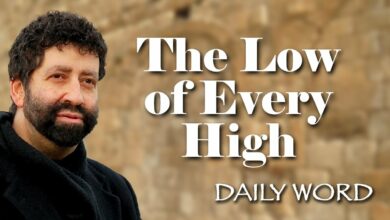Revelation, The Seven Lampstands, & The Secrets Of Victory | Jonathan Cahn Sermon
Revelation, The Seven Lampstands, & The Secrets Of Victory
Jonathan Cahn continues unlocking The Book of Revelation with the opening vision of Revelation, one that has to do with all of God’s people, the Church age, and each of our lives and callings.
Many churches today have lost sight of the One who was meant to be at the center—Jesus. Though they still function outwardly, they are like empty buildings, like lampstands without light. It’s possible to lose Him, even while doing things in His name. You can even lose Him in the lampstand if you focus on the structure, the ministry, or the motions instead of Him.
In Revelation 1:10, John writes, “I was in the Spirit on the Lord’s Day, and I heard behind me a loud voice like a trumpet.” That voice said, “Write what you see in a scroll and send it to the seven churches: Ephesus, Smyrna, Pergamum, Thyatira, Sardis, Philadelphia, and Laodicea.” When John turned, he saw something powerful: seven golden lampstands.
This is the first time the number seven appears in Revelation (besides the churches), but it becomes central: seven seals, seven bowls, seven trumpets, seven angels, seven stars. In Scripture, seven symbolizes completeness—seven days of creation, seven days in a week. Revelation is a book about completion. That’s why it opens with seven golden lampstands—symbols of divine light.
Light is key. The first act of creation in Genesis was, “Let there be light.” And here, in the final book of the Bible, we see light again—seven lamps. Revelation begins and ends with light. It opens with lampstands and ends in chapter 22 with, “There will be no more night. They will not need the light of a lamp or the sun, for the Lord God will give them light, and they will reign forever.”
So the Bible starts and ends with light. And in between, there’s darkness—trials, sin, and struggle. But the message is clear: for those who belong to God, the end will always be light. Even when you’re in the middle of a dark season, hold onto this promise—light is coming.
In the Hebrew Scriptures, the word for light is “or.” The lampstand is called the “menorah,” a word built around “or.” In Exodus 25, God commands the construction of a golden lampstand with seven branches. That same seven-branched menorah stood in the Holy Place of the Tabernacle, illuminating the sacred space alongside the bread of the Presence and the altar of incense.
There was no electricity. This divine lamp was the only light source. It revealed what otherwise couldn’t be seen in the darkness. John’s vision draws directly from this imagery. Revelation is filled with temple symbolism—lampstands, veils, priesthood, and sacred space.
The very word “Revelation” in Greek is “Apokalypsis,” meaning “to unveil.” In the temple, veils separated the outer courts from the Holy of Holies. But through Christ—through the Lamb who was slain—we are given access. Revelation removes the veil and leads us into God’s most intimate presence.
